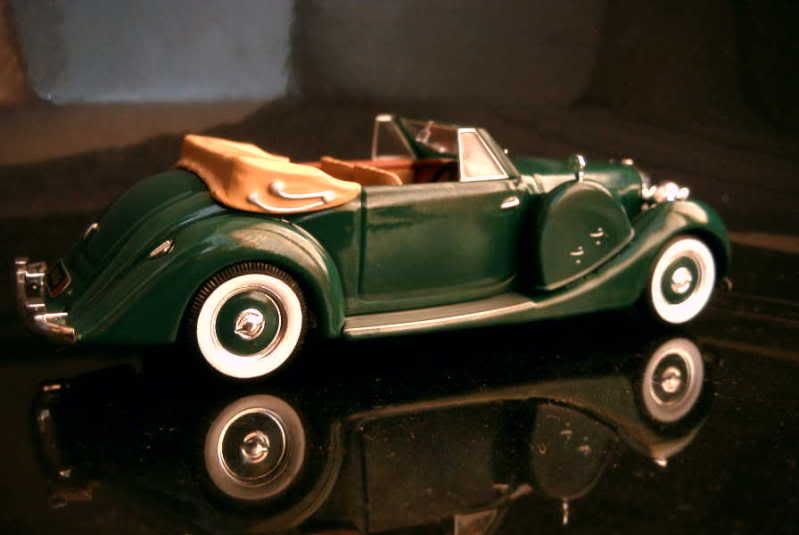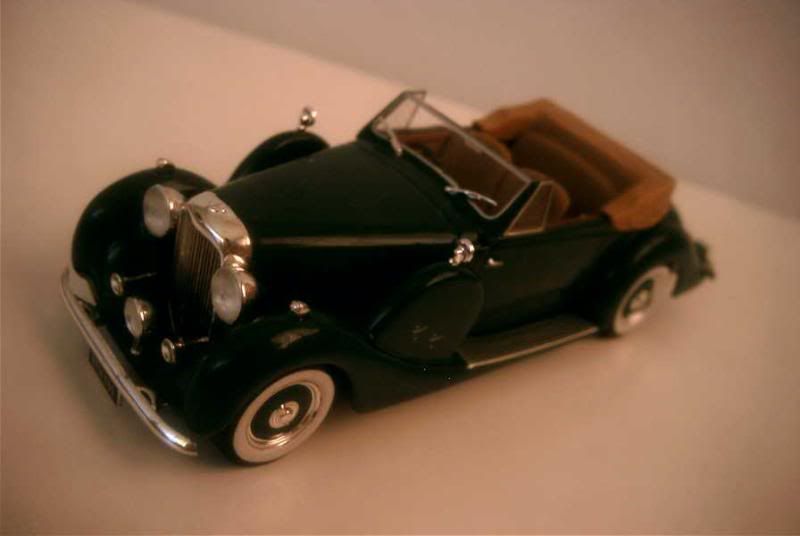A little history
This little manufacturer from the Middlesex town of Staines already had a long history when it released its LG6, having been founded by American entrepreneur Wilbur Gunn as early as in 1906. Today is still attached to it the image of yet another brand of typical tourers, made to travel around the countryside with its top down whatever the weather can be, with a moustached, retired British Army colonel proudly sitting behind the wheel of his machine. Though not untrue, Lagonda nevertheless made a difference by being reasonably innovative in a very conservative British automotive landscape.
The worst and the best in Lagonda’s history came in 1935. That year, the little factory both was placed in receivership and recorded its greatest racing success ever, a (lucky) victory at the prestigious Le Mans 24 hours, a feat we’ll discuss another time. Regarding its troubles, a saviour appeared in the guise of a certain Alan Good, who purchased the company and restored its financial buoyancy. Good then attracted a well-known engineer to Staines: no less than W.O. Bentley himself. Working for the company bearing his name after he was forced to sell it to Rolls-Royce was apparently unsatisfactory, and Bentley was glad to undertake the design of the next Lagonda.
The company’s flagship was then the M45. With a six-cylinder, 4.5-litre block – hence the name – provided by Meadows as Lagonda purchased most of its engines from independent suppliers, the standard M45 could reach about 150 kph, not a bad performance at that time. Those asking for more could order the Rapide, a tuned up, shortened version of the M45. Bentley soon revamped the line into the LG45, but a brand new car had to wait a little more.
Lagonda’s management gave the go-ahead for the release of the new LG6, the successor of the LG45, in 1937. The car was ready on time to be introduced at Earl’s Court during the London motor show, alongside a prestigious yet closely-related V12 model. The 4.5-litre engine of the M45 and LG45 was retained, though it enjoyed such refinements as a twin ignition system: spark plugs being regularly faulty in those days, two of them were mounted on each cylinder. The chassis was also reworked. A torsion bar system provided an independent suspension at the front, while the brakes were now applied through a hydraulic system by Girling. With two carburettors and 140 bhp, the standard models’ performances remained interesting, but the Rapide version, though carried over, appeared heavier and tamer than its previous incarnations.
The career of this interesting car was interrupted in 1940. Though production on a limited scale was maintained during the first months of the war, building exclusive automobiles while the country’s defense requested the gathering of all of its resources in order to win the Battle of England soon proved pointless.
Though the Staines factory resumed production after the conflict, by 1947 it was purchased by David Brown, the agricultural appliances’ magnate who had just acquired Aston Martin. Though Lagondas were built for some time more, they were soon sacrificed in order to concentrate on Aston Martins. Though inevitable at the time, it surely was a mistake on the long run, as can be asserted by the many attempts by Aston Martin to revive the Lagonda name since then.
About the model
Model: Lagonda LG6 Drophead Coupe
Year: 1938
Maker: Ixo
Scale: 1/43
Distributed by: Altaya as no.22 of its Voitures Classiques press series
Acquired: brand new, in August 2006, in Souillac, France
Altaya proposed this magnificent LG6 in its Voitures classiques series. In my opinion, this certainly was one of the best models released in this collection: elegant car, nice details, good paint job. My rating is 15/20.




This little manufacturer from the Middlesex town of Staines already had a long history when it released its LG6, having been founded by American entrepreneur Wilbur Gunn as early as in 1906. Today is still attached to it the image of yet another brand of typical tourers, made to travel around the countryside with its top down whatever the weather can be, with a moustached, retired British Army colonel proudly sitting behind the wheel of his machine. Though not untrue, Lagonda nevertheless made a difference by being reasonably innovative in a very conservative British automotive landscape.
The worst and the best in Lagonda’s history came in 1935. That year, the little factory both was placed in receivership and recorded its greatest racing success ever, a (lucky) victory at the prestigious Le Mans 24 hours, a feat we’ll discuss another time. Regarding its troubles, a saviour appeared in the guise of a certain Alan Good, who purchased the company and restored its financial buoyancy. Good then attracted a well-known engineer to Staines: no less than W.O. Bentley himself. Working for the company bearing his name after he was forced to sell it to Rolls-Royce was apparently unsatisfactory, and Bentley was glad to undertake the design of the next Lagonda.
The company’s flagship was then the M45. With a six-cylinder, 4.5-litre block – hence the name – provided by Meadows as Lagonda purchased most of its engines from independent suppliers, the standard M45 could reach about 150 kph, not a bad performance at that time. Those asking for more could order the Rapide, a tuned up, shortened version of the M45. Bentley soon revamped the line into the LG45, but a brand new car had to wait a little more.
Lagonda’s management gave the go-ahead for the release of the new LG6, the successor of the LG45, in 1937. The car was ready on time to be introduced at Earl’s Court during the London motor show, alongside a prestigious yet closely-related V12 model. The 4.5-litre engine of the M45 and LG45 was retained, though it enjoyed such refinements as a twin ignition system: spark plugs being regularly faulty in those days, two of them were mounted on each cylinder. The chassis was also reworked. A torsion bar system provided an independent suspension at the front, while the brakes were now applied through a hydraulic system by Girling. With two carburettors and 140 bhp, the standard models’ performances remained interesting, but the Rapide version, though carried over, appeared heavier and tamer than its previous incarnations.
The career of this interesting car was interrupted in 1940. Though production on a limited scale was maintained during the first months of the war, building exclusive automobiles while the country’s defense requested the gathering of all of its resources in order to win the Battle of England soon proved pointless.
Though the Staines factory resumed production after the conflict, by 1947 it was purchased by David Brown, the agricultural appliances’ magnate who had just acquired Aston Martin. Though Lagondas were built for some time more, they were soon sacrificed in order to concentrate on Aston Martins. Though inevitable at the time, it surely was a mistake on the long run, as can be asserted by the many attempts by Aston Martin to revive the Lagonda name since then.
About the model
Model: Lagonda LG6 Drophead Coupe
Year: 1938
Maker: Ixo
Scale: 1/43
Distributed by: Altaya as no.22 of its Voitures Classiques press series
Acquired: brand new, in August 2006, in Souillac, France
Altaya proposed this magnificent LG6 in its Voitures classiques series. In my opinion, this certainly was one of the best models released in this collection: elegant car, nice details, good paint job. My rating is 15/20.







4 comments:
I always have a soft spot for classic cars, this Lagonda is very beautiful! Congrats sir Laurent!
Thank you so much Mike. Good to know you like classics, as prewar cars lovers are only a minority among die-casts collectors.
yeah if only i get to win the lotto, i would surely add a lot of pre war classics in my collection. ;-)
So strange that any collector's two major problems are always money and space... ;)
Post a Comment